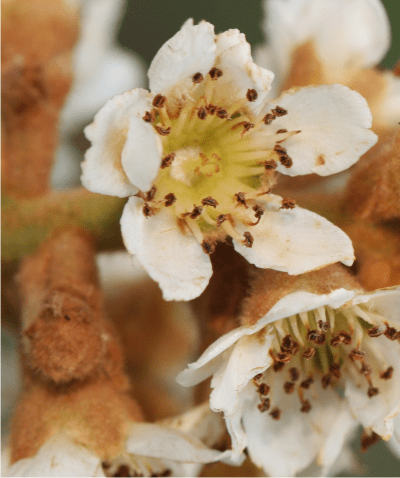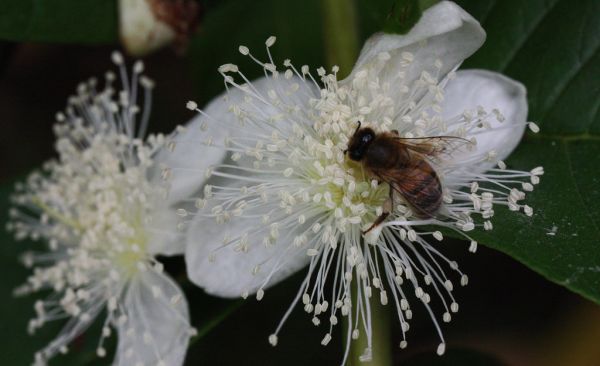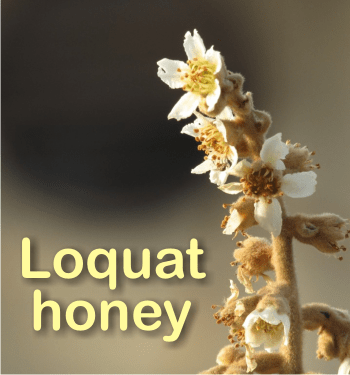Loquat honey is a type of honey more popular in Asia than in the other parts of the world, known a lot for its laxative and relaxing properties. With the exception of Italy and Spain, no European ever heard about loquat honey.
Name: Loquat
Other names: Japanese medlar, Japanese plum, Chinese plum or pipa in China.
Scientific name: Eriobotrya japonica
Family: Rosaceae. There are about 20 species of these evergreen trees and shrubs common in Japan and China.
Native to: the cooler hills of China to south-central China, also introduced in Japan, Korea, India, Potohar and Pakistan, Philippines, Sri Lanka.
It is also found in some southern European countries such as Turkey, Cyprus, Malta, Italy, Albania, Spain and Portugal; and several Middle Eastern countries including Morocco Algeria, Iran, Syria, Iraq, Jordan, Israel, Palestine and Lebanon.
Main characteristics:
It is a large evergreen shrub or tree, that grows well in hot mild climate, where the temperature is not below the freezing point. At -3°C flowers and fruits get harmed.
It is grown commercially for its yellow fruit and also cultivated as an ornamental plant. It has a rounded crown a short trunk and woolly new twigs.
The leaves are alternate, simple, 10–25 cm (4–10 in) long, dark green, tough and leathery in texture, with a serrated margin, and densely velvety-hairy below with thick yellow-brown pubescence.
The whitish flowers appear in autumn or early winter and the bloom period lasts at least 2 months. The flowers are 2 cm (1 in) in diameter, white, with five petals, and produced in stiff panicles of three to ten flowers. They have a sweet, heady aroma that can be smelled from a distance.
Loquat starts to yield fruit 2-3 years after vaccination. At the age of 10-12 they come to the level of economic yield. Their most productive terms are the first 23-25 years.
The fruits are ripe at any time from early spring to early summer. One tree produces up to 150 kg of fruits. They are small, spherical, oval or pear-shaped, with a thin skin and a juicy sour-sweet pulp, grow by 8-12 pieces. Ripe fruit becomes brownish-red or yellowish with brown flesh. After frost they are edible, have a characteristic astringent taste.
The fruits are different because there are many Eriobotrya japonica cultivars. Based on its origin, 2 groups are distinguished:
– the Chinese groups with large, pyriform, deep orange fruit, which can be kept for 1-2 weeks,
– the Japanese group with small, slender, light-coloured fruit, maturing early and with a shorter shelf life.
 picture credit Rickjpelleg and Garhi Banoorian Kohat
picture credit Rickjpelleg and Garhi Banoorian Kohat
Pollination: Wind plays little or no role in loquat pollination process. The flowers attract very limited number of bee visitors: A. mellifera, Anthophora albigena and Xylocopa violocea of family Apidae and Halictus quadricinctus of family Halictidae.
It was observed that in the trees that aren’t fertilized with bees, 4% of flowers fructify; whereas the flowers that are fertilized with bees fructify at the rate of 83 %. Bees perch on approximately 120 thousand flowers to produce 1 gram honey. 450 grams honey is accumulated with 17 thousand bees flying on 120 thousand flowers.
Pollen and nectar. Loquat flowers are very rich in both nectar and pollen and have a prominent fragrance. And since there are no other flowers in the environment in winter months, bees benefit from loquat nectar and pollen in this period.
• In a study from 2012, Turan KARADENIZ and his team measured the loquat pollen grains from the loquat trees that grow in Ordu, Turkey. In the measurements of 10 pollen from the loquat plant trees that are grown in Ordu, it has been observed that: the height of pollen is between 1.299-1.799 mm; the breadth of pollen is between 0.925- 1.267 mm; the average pollen height is 1.517 mm, pollen breadth 1.116 mm.
• According to a study from June 2019, conducted by Song YQ, xylosidase, thaumatin, and two kinds of chitinases were detected in loquat floral nectar and their activity in loquat nectar and honey were quantified.
Following gel electrophoresis, loquat honey had similar chitinase activity profiles to loquat nectar. This discovery makes floral nectar chitinase a potential marker for monofloral honey botanical origin authentication.

What is loquat honey?
Color: amber with golden reflections
Aroma: very fruity, reminiscent of the fruit
Flavor: smooth with fruity touches.
Humidity: high
Crystallization: due to its high humidity, it usually crystallizes in two layers with a coarse grain size: one amber-colored solid, reminiscent of the same fruit and another dark brown.
Health Benefits of Loquat Honey
Harvested in early spring, loquat honey has laxative and relaxing properties. It helps hair and nail growth. It is used for sour throats and respiratory diseases.
Is loquat honey good in cuisine?
The loquat honey matches very well with ice cream and dark chocolate
The loquat has a high sugar, acid and pectin content. It is eaten as a fresh fruit and mixes well with other fruits in fresh fruit salads or fruit cups. It is commonly used to make jam, jelly and chutney and are often served poached in light syrup. Firm, slightly immature fruits are best for making pies or tarts.
Loquats can also be used to make light wine. In Italy nespolino liqueur is made from the seeds, reminiscent of nocino and amaretto, both prepared from nuts and apricot kernels.
Though both the loquat seeds and the apricot kernels contain cyanogenic glycosides, the drinks are prepared from varieties that contain only small quantities so there is no risk of cyanide poisoning.
Medicinal use of loquat:
Loquat fruit and leaves have high concentrations of vitamin-A, ascorbic acid, calcium, iron, manganese, potassium, and pharmacologically active constituents are kaempferol, ursolic-acid, oleanolic-acid, tartaric acid, quercetin, amygdalin and others.
It is said to possess various pharmacological activities such as antioxidant, anti-inflammatory, hypo-lipidemic, anti metastatic activity, antidiabetic, antibacterial, analgesic, antiemetic, antitussive, antiviral, astringent, diuretic, expectorant, sedative activities. (here are more details on medicinal properties of loquat)
Its leaves are listed in the Japanese Pharmacopeia and are used widely as traditional herbal medicine for the treatment of chronic bronchitis and coughs.
The fruits have been used since time immemorial in the ethno medicine for numerous diseases including asthma, gastroenteric disorders, diabetes mellitus common cold and chronic liver disorders.
The fruits strengthen the intestines and improve digestion. Decoctions of unripe fruits and seeds treat inflammatory diseases of the gastrointestinal tract, bloody diarrhea, urolithiasis.
Eaten in quantity, loquats have a gentle but noticeable sedative effect, lasting up to 24 hours.
Loquat syrup is used in traditional Chinese medicine for soothing the throat and is a popular ingredient in cough drops. The leaves when combined with other ingredients is known as pipa gao (literally “loquat paste”)
In Japan, loquat leaves are dried to make a mild beverage known as biwa cha, by brewing them using the traditional Japanese method.
The legend of loquat
“A young man lived in a village. He loved the rich but sickly girl. He could not woo her, as he had no sheep, no decent clothes, and he walked barefoot. Young mother could not look at his suffering. She decided to help him, went into the garden and wanted to cut down a loquat tree to sell its valuable timber.
She touched the bark of a tree and heard a groan: “Do not kill me, I will be of use”. The woman did not cut down a tree. In spring she gathered unripe fruit and carried them to cobbler, so he could make the tanning for the leather, and then sewed the boots for her son.
From ripe fruit she cooked a delicious candy. In their garden in the same year there were so many loquat that they were selling it in the market. And soon, the son was able to buy new clothes. Dressed up, he went to his girlfriend, but she was sick.
The young man asked the servants to give to the girl juice and candy from the loquat. Girl tasted gifts, she liked the flavor, she asked to bring her more. The young man began to come every day to bring loquat to beloved one.
Soon she felt better, she did not want to lie down all day on the mat. She went out and met the boy. In his new clothes and high boots he was so handsome that she, too, fell in love. She told her parents that she agreed to marry the young man. And soon they were married.” (source: keepingbee.org)
 picture credit Robyn Jay via flickr.com
picture credit Robyn Jay via flickr.com
**********
https://aceitecsb.com/en/buy/loquat-honey-baron-de-turis-500-g/
https://www.academia.edu/9951532/Fruit_set_and_quality_of_loquats_Eriobotrya_japonica_as_effected_by_pollinations_under_sub-humid_Mediterranean
LOQUAT AS A SOURCE OF NECTAR AND POLLEN IN THE WINTER FOR BEEKEEPING
Loquat flower from featured picture credit kami rao via flick.com




